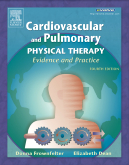|
|
|
| |
 |
|
|

|
 推薦指數:
推薦指數:





|
|
- 內容介紹
|
Cardiovascular and Pulmonary Physical Therapy, 4th Edition - Evidence and Practice
By Donna Frownfelter, PT, DPT, MA, CCS, RRT, FCCP and Elizabeth Dean, PhD, PT
864 pages 343 ills
Trim size 8 1/2 X 10 7/8 in
Copyright 2006
Description
Uniquely balanced in its coverage of cardiac and pulmonary systems in health and dysfunction, this student-friendly text includes a new holistic perspective on providing care. Based on the latest scientific literature and research, the text sets the foundation with strong A&P, assessment and intervention coverage. The focus of the rehabilitation section is on the patient, detailing therapy guidelines for patients with acute, chronic and critical care conditions, while also addressing special patient population, such as pediatrics and the elderly. The fourth edition expands its coverage of secondary conditions and has additional content on health care trends related to evidence-based management to promote cost-effective management. The concept of oxygen transport is interwoven throughout.
Key Features
Integrates real-life, clinical cases within the textbook to enable the reader to apply concepts covered in the chapter.
Content covers the spectrum from acute to long-term conditions.
Covers secondary cardiovascular/cardiopulmonary conditions as well as primary conditions.
Special topics are highlighted at the end to keep abreast of new directions and initiatives in the specialty.
Focuses on evidence-based medicine to bridge the gap between the importance of research to reimbursement.<
Evolve Learning Resources Website includes an Electronic Image Collection with all the images from the book for instructors. For students, a Clinical Case Study Guide provides additional cases to develop problem-solving and clinical reasoning skills.
New to this Edition
Emphasizes the global perspective of health to make students more aware of the cross-cultural and global view of health care.
Expanded section on health psychology and living a healthy lifestyle.
Expanded section on secondary cardiovascular and pulmonary conditions shows that “every patient” is a cardiovascular and pulmonary patient.
Integrates oxygen transport throughout to demonstrate how cardiac and pulmonary function together.
Focuses on evidence-based medicine to bridge the gap between the importance of research and reimbursement
Uses case vignettes as models of evidence-based practice and clinical decision making to help the student apply real-life scenarios to evidence-based practice and the process of decision making.
Pharmacology chapter has been substantially revised and updated to show the importance of pharmacology to cardiopulmonary care.
Incorporates The Guide to Physical Therapist Practice, 2nd Edition, which sets the standard in physical therapy.
New appendix with a prototype for a cardiac rehabilitation program and a pulmonary rehabilitation program enables the readers to understand how rehabilitation programs work.
Expanded section on community and home care.
New information on noninvasive mechanical ventilation.
Table of Contents
PART 1. CARDIOVASCULAR AND PULMONARY FUNCTION IN HEALTH AND DISEASE 1. Epidemiology as a Basis for Contemporary Physical Therapy Practice 2. Oxygen Transport: The Basis of Cardiopulmonary Physical Therapy 3. Cardiopulmonary Anatomy 4. Cardiopulmonary Physiology 5. Cardiopulmonary Pathophysiology 6. Cardiopulmonary Manifestations of Systemic Conditions PART II. CARDIOVASCULAR AND PULMONARY ASSESSMENT 7. Measurement and Documentation 8. History 9. Pulmonary Function Tests 10. Arterial Blood Gases 11. Imaging of the Chest 12. Electrocardiogram Identification 13. Multisystem Assessment and Laboratory Investigations 14. Special Tests 15. Clinical Assessment of the Cardiopulmonary System 16. Monitoring Systems in the Intensive Care Unit PART III. CARDIOVASCULAR AND PULMONARY PHYSICAL THERAPY INTERVENTIONS 17. Optimizing Outcomes: Relating Interventions to an Individual’s Needs 18. Mobilization and Exercise 19. Body Positioning 20. Physiological Basis for Airway Clearance Techniques 21. Airway Clearance Interventions: Clinical Application 22. Facilitating Airway Clearance with Coughing Techniques 23. Facilitating Ventilation Patterns and Breathing Strategies 24. Exercise Testing and Training: Primary Cardiopulmonary Dysfunction 25. Exercise Testing and Training: Secondary Cardiopulmonary Dysfunction 26. Respiratory Muscle Training 27. Complementary Therapies as Cardiopulmonary Physical Therapy Interventions 28. Patient Education PART IV. GUIDELINES FOR THE DELIVERY OF CARDIOVASCULAR AND PULMONARY PHYSICAL THERAPY: ACUTE CONDITIONS 29. Individuals with Acute Medical Conditions 30. Individuals with Acute Surgical Conditions PART V. GUIDELINES FOR THE DELIVERY OF CARDIOVASCULAR AND PULMONARY PHYSICAL THERAPY: CHRONIC CONDITIONS 31. Individuals with Chronic Primary Cardiopulmonary Dysfunction 32. Individuals with Chronic Secondary Cardiopulmonary Dysfunction PART VI. GUIDELINES FOR THE DELIVERY OF CARDIOVASCULAR AND PULMONARY PHYSICAL THERAPY: CRITICAL CARE 33. Comprehensive Management of Individuals in the Intensive Care Unit 34. Intensive Care Unit Management of Individuals with Primary Cardiopulmonary Dysfunction 35. Critical Care Management of Secondary Cardiopulmonary Dysfunction 36. Complications, Acute Respiratory Distress Syndrome, Shock, Sepsis, and Multiorgan System Failure PART VII. GUIDELINES FOR THE DELIVERY OF CARDIOVASCULAR AND PULMONARY PHYSICAL THERAPY: SPECIAL CASES 37. The Neonatal and Pediatric Patient 38. The Aging Patient 39. The Patient with Multisystem Impairments Affecting Breathing Mechanics and Motor Control 40. The Transplant Patient 41. The Patient in the Community PART VIII. RELATED ASPECTS OF CARDIOVASCULAR AND PULMONARY PHYSICAL THERAPY 42. Body Mechanics-The Art of Positioning and Moving Patients 43. Respiratory Care Practice Review 44. Care of the Patient with an Artificial Airway 45. Respiratory and Cardiovascular Drug Actions Glossary Index
|
|
|

